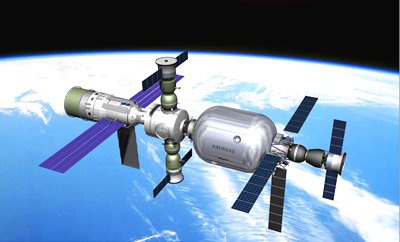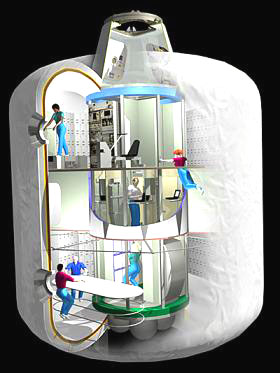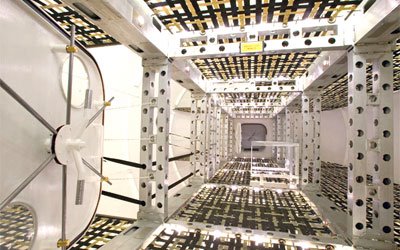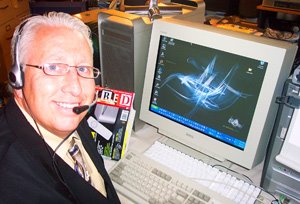Five Billion Star Hotel!
:: Need to get away from it all? Extreme Technology presents a tour of the CSS Skywalker, an orbital resort that’s a lot closer to reality than you might think!
++ Aviation and Space: Robert Bigelow / Earth Orbiting Hotel!
When it comes to grand ambition, the impresarios of the Las Vegas Strip are mere pikers next to Budget Suites owner Robert Bigelow. For his next hotel enterprise, Bigelow is looking beyond the bright lights of Las Vegas—beyond Earth’s atmosphere, in fact. He is actively engaged in an effort to build the planet’s first orbiting space hotel.
 For its water show, this hotel will have all of Earth’s blue oceans flying past its windows at 17,500 miles an hour. Guests on board the 330-cubic-meter station (about the size of a three-bedroom house) will learn weightless acrobatics, marvel at the ever-changing face of the home planet, and, for half of every 90-minute orbit, gaze deep into a galaxy ablaze with billions of stars.
For its water show, this hotel will have all of Earth’s blue oceans flying past its windows at 17,500 miles an hour. Guests on board the 330-cubic-meter station (about the size of a three-bedroom house) will learn weightless acrobatics, marvel at the ever-changing face of the home planet, and, for half of every 90-minute orbit, gaze deep into a galaxy ablaze with billions of stars. Developed at NASA as part of a project called TransHab, inflatable space-station modules have some important advantages over their tin-can counterparts. They weigh significantly less, and they launch in a compressed state, with their fabric hulls wrapped tightly around their rigid cores like a roll of paper towels. This allows them to use less-powerful launch vehicles and makes for roomier space stations.
Developed at NASA as part of a project called TransHab, inflatable space-station modules have some important advantages over their tin-can counterparts. They weigh significantly less, and they launch in a compressed state, with their fabric hulls wrapped tightly around their rigid cores like a roll of paper towels. This allows them to use less-powerful launch vehicles and makes for roomier space stations.After a rocket fires a Nautilus into space, explosive bolts will release the girdle securing the compressed hull, and then the station’s life support system, housed in the core, will inflate the structure with breathable air, expanding it from 15 feet in diameter to 22 feet.
Power comes from solar panels that unfold from the rigid bulkheads at each end of the module. Each bulkhead also houses an airlock and a docking adaptor. Astronauts arriving later enter a shirtsleeve environment in which they can go to work unpacking removable panels, equipment and supplies from the core to create three levels of living and working space.
A docked rocket engine called a multi-directional propulsion bus (MDPB) will eventually allow the station—the first one is tentatively called CSS [Commercial Space Station] Skywalker—to maneuver within Earth’s orbit or even leave it, for, say, a trip to the moon.
 Welcome to your Space Hotel Lobby! Fiberglass panels will cover the fabric webbing, visually dividing the module’s living areas. Open passages will connect the levels.
Welcome to your Space Hotel Lobby! Fiberglass panels will cover the fabric webbing, visually dividing the module’s living areas. Open passages will connect the levels.Note from Technophile: This basic architecture was created by NASA senior engineer William Schneider, in an effort that began in 1997. The design won numerous converts at NASA, with then- administrator Daniel Goldin calling it a major breakthrough. For a while, it was seriously considered as an alternative to the International Space Station (ISS) Habitation Module under development at the time by Boeing. But TransHab was cancelled without explanation in 2000, before it could produce flight-ready hardware. Its demise is an example of what Bigelow sees as NASA’s monumental inefficiency. Here was a perfectly good program to develop a technology that was less expensive and tougher than conventional designs, but, as far as Bigelow could tell, it got axed for purely political reasons.:: Source: [Bigelow Aerospace]
:: Innovation: Making living in space available to humans (other than astronauts)!
:: Available: January 10, 2010 (make your reservations)!
:: Cost: Bargain basement hotel prices start at $7.9 million per week (a bargain compared to the $20 millions it costs to live on the ISS for a week)!




















0 Comments:
Post a Comment
<< Home